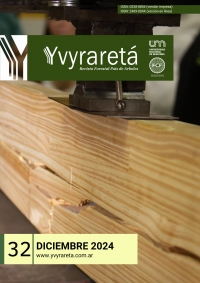ÍNDICE
ARTÍCULOS CIENTÍFICOS
-
Análisis químico y poder calorífico de cinco especies comerciales de madera en Misiones. Chemical analysis and calorific power of five commercial wood species in Misiones.Adelaida Bragañolo │ Iris Figuedero │ Daniel Schamne │ Marina Hornus
-
Rendimiento en el aserrado por grados de calidad para apariencia y remanufactura en taxones de pinos en el Noreste de Argentina. Sawing yield by quality grades for appearance and factory in pine taxa in NE Argentina.Rosa Ángela Winck │ Ector Cesar Belaber │ Diego Rolando Aquino │ Christian Bulman Hartkopf │ Cristian Andrés Rotundo │ María Elena Gauchat │ Hugo Enrique Fassola
-
Crecimiento de cinco especies arbóreas nativas a los 10 años de edad en el NE de Corrientes. Growth of five native tree species at 10-year-old in NE CorrientesSilvana L. Caldato │ Raúl V. Pezzutti │ Christian Chrapek │ Raul Schenone │ Noelia May Petroff │ Federico Montiel
-
Efecto de diferentes sustratos, contenedores y ambientes sobre el crecimiento y calidad de plantines de Neltuma caldenia. Effect of different substrates, containers and environments on the growth and quality of Neltuma caldenia seedlingsMarco Jesús Utello │ Eugenio Lusso │ Juan Carlos Tarico │ Marcela Alejandra Demaestri │ José Omar Plevich
FICHA TÉCNICA
-
Manejo de frutos y semillas, producción de plantines y establecimiento a campo de especies nativas Myrocarpus frondosus Allemão (Incienso). Familia: FabaceaeBeatriz Irene Eibl │Cecilia González │Gabriel Ramón Ortiz

